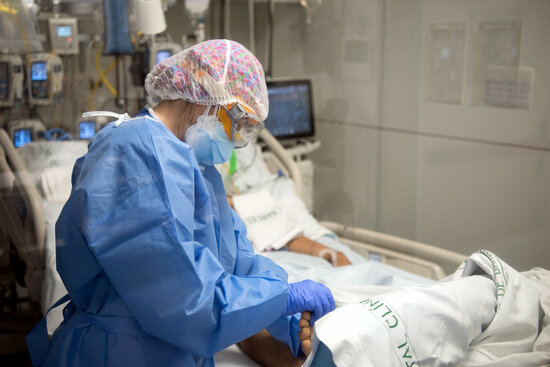Why Catalonia tops Covid incidence rate rankings in Europe
Sant Joan festivities, opening of nightlife and Delta variant contributed to fifth wave of pandemic, says BIOCOM-SC group researcher

The vaccination rollout was in full force, with half of the population having received at least one dose, the number of hospitalizations due to Covid-19 was at its lowest in a year, the rest of the pandemic figures were also marking record lows… and the general mood was optimistic around June 20, only a month ago.
Authorities felt that the health crisis was once and for all under control and they began to ease the restrictions. No more obligation to wear face masks outdoors, end of the cap on gatherings of 10 people and the reopening of nightlife were only some of the long-awaited measures enforced those days.
This happened right as summer was beginning - a summer deemed to be much better than the previous one -, and some of this season’s typical activities were permitted to take place, such as summer music festivals and end-of-course trips. Also, Sant Joan, the customary summer solstice celebration with fire and beaches full of revelers.
On the eve of Sant Joan, June 23, some news of a Covid outbreak among students after an end-of-course trip to the Canary Islands went unnoticed by the public opinion - also, other similar outbreaks of students celebrating the end of classes in the Balearic Islands on June 25. The public opinion was focused on the removal of the face mask mandate the following day.
Yet, in the days immediately after, madness. The record lows in the Covid-19 figures soon vanished and gave way to unprecedentedly high rates of transmissions. Under 1,000 new cases per day became 8,000 in roughly a week and hospitalizations, although without such sharp increases, have trebled in the past fortnight. The Delta variant accounts for 90% of the new cases, which especially impact young people.
Authorities took a few days to react, but then rushed to reimpose the cap on gatherings and the curfew, while closing again the indoors areas of nightclubs and recommending local councils to close beaches and parks.
Why is Catalonia the territory of the EU with the second highest incidence rate at the moment? Catalan News has made this Filling the Sink podcast to find out.
The podcast includes an interview with Enric Álvarez, a researcher at UPC (Polytechnic University of Catalonia), biophysicist and member of BIOCOM-SC (Computational Biology and Complex Systems).
Why have Covid transmissions skyrocketed?
The first was the large increase in cases that happened after Sant Joan festivities with the general celebration and long weekend and holidays for students. The pandemic was basically going down and then when they started to open leisure places, discos and all that activity, the pandemic started to grow again but for the first week it was really standard growth like the one we've seen in England. At that time the Delta variant was roughly at 50% and then suddenly it made a jump from one week to another, the number of cases multiplied by four. There was a huge amount of high-risk environment interactions, in large gatherings, outdoors but very crowded, without masks, or interiors, people living together for a long time [on holidays], and the secondary attack rates for these kind of “long-living” parties or party-related activities are huge with the Delta.
Was the explosion in cases in any way predictable?
No, I think it's not predictable in the sense that when you have such large festivities you really don't know what's going to happen. They expected that [opening] leisure will lead to increases. They also expected that the Delta was going to start. It’s true now that it came at exactly the worst level. The transmission is really amazingly higher with the Delta than with the Alpha. And then it came, the out-of-nowhere large meetings and “living-together” trips, like students, young people, 30s, 40s, just took one week of holidays together, hundreds of people at the same time. You don't expect everything that could go wrong to go wrong.
Should action have been taken earlier?
If you only look at the epidemiological perspective you would have sustained the measures that prevent high risk environments until everyone 35 and above is completely vaccinated. The question is, you have the other side of the issue, cases are going down, the hospitalisations were really going down and more importantly you know that even in the situation that we are in today, it's not going to see a very large increase in the number of casualties, of deaths associated with Covid-19. Compared with the situation without vaccines, it's more difficult to introduce measures or scale back measures at least until you see a clear increase in the level of hospital requirements. Even when you see that primary care is going to be overflowed by people, sometimes it's difficult to take these preventive actions ahead of time.
How will this fifth wave develop from here?
So what happens next probably is that there is a saturation in the level of infections of young people. Right now, there are estimations that roughly 20%, 15% of young people should be at home, quarantining, in Catalonia, 15, 20%. If [cases of people in their 30s and 40s] keep growing, if they still socialise in high risk environments, then it's going to be a real issue in the hospitals, and the second key question that we don't know exactly yet is how the 50 to 70-year-olds that only have one dose are going to react to this increase in cases. The data from the UK is not good at all about what the effects are of only having one dose, and the 60s to 70 bracket, a lot of them are just right now getting the second dose, so they are nowhere near immunized completely. Let's see what happens in the next few weeks.